Vacuum Insulation Panels Market Research, 2032
The global vacuum insulation panels market size was valued at $8.1 billion in 2022, and vacuum insulation panels industry is projected to reach $12.7 billion by 2032, growing at a CAGR of 4.7% from 2023 to 2032.
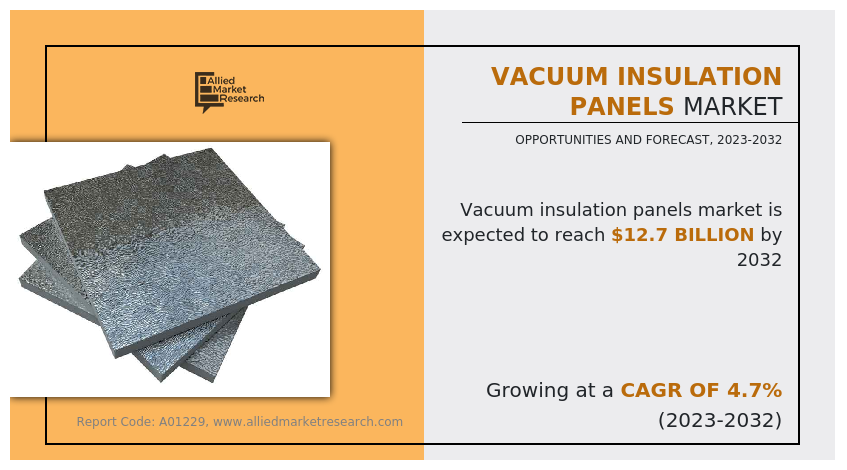
Vacuum insulated panel is a form of thermal insulation consisting of a gas-tight enclosure surrounding a rigid core, from which air has been evacuated. It has a wide range of applications in building construction, refrigerating units, and insulated shipping containers to provide better insulation performance than conventional insulation materials. The global vacuum insulation panels market is driven considerably owing to the growth in construction and the increase in the demand for cold storage containers in the transportation sector. Rapid industrialization and urbanization have bolstered the demand for the construction sector. The ever-increasing global warming has led to various climatic changes, thereby creating an opportunity for the demand for vacuum insulation panels in the construction sector.
The presence of highly developed marine transportation infrastructure across the globe among developed and developing countries has a positive impact on the demand for the vacuum insulation panels market. The presence of a huge population, an increase in middle-class income, and urbanization has created opportunities for the development of the vacuum insulation panels market.The main reasons that hinder the development of the market are the relatively high cost as compared to conventional insulation materials; their great sensibility to mechanical damage as puncturing the vacuum insulated panel envelope causes an increase in the thermal conductivity; and a decrease in their durability and consequent performance along their whole lifespan.
The global vacuum insulation panels market forecast is segmented on the basis of raw material, core material, type, end use, and region. On the basis of raw material used for manufacturing, the market is segmented into plastics and metals. The core material segment of the vacuum insulation panels market is broadly classified into silica, fiberglass, and others. The type segment of the vacuum insulation panels market is broadly classified into flat panel and special shape panel. The end use of the market is categorized into construction, cooling & freezing devices, logistics, and others. The global vacuum insulation panels market is analyzed across four regions, namely North America, Europe, Asia-Pacific and LAMEA.
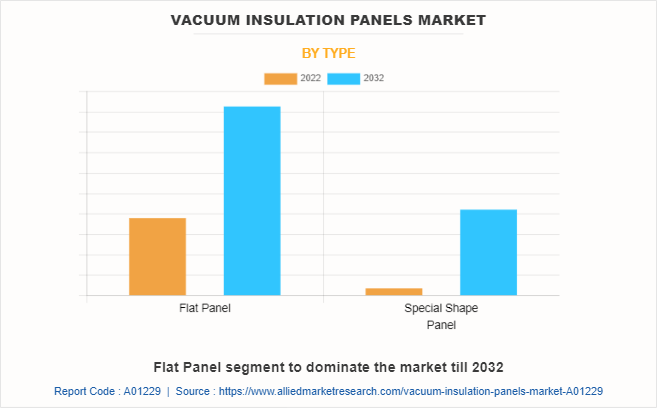
By type, the flat panel segment accounted for nearly three-fifths of the global market share in 2022. . It is characterized by a compact size and high thermal resistance values, which result in high thermal insulation. These panels can be used in building constructions, cooling & freezing devices, and also in the logistics industry. Growth of the segment is driven by the design flexibility and ease-to-manufacture attributes of flat panels. Increasing stringent regulations promoting energy-efficient materials, and R&D initiatives to introduce automated panels, with an aim to reduce VIPs cost are expected to provide opportunities for the market, during the forecast period.
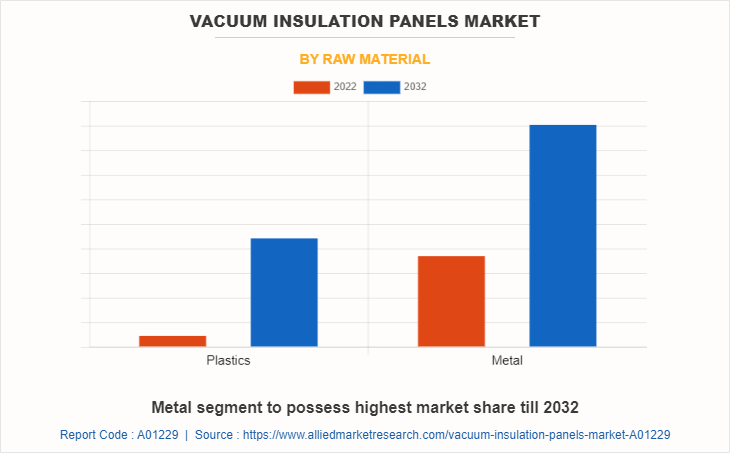
By raw material, the metal segment accounted for nearly three-fifths of the global market share in 2022. These panels will be used for insulation in buildings, offering energy efficiency, and meeting stricter building codes and regulations. The rise in e-commerce, cold chain logistics, and expansion of the construction industry across the globe is expected to drive vacuum insulation panels market growth. The increase in awareness related to sustainability and recycling of raw materials from waste products will provide many opportunities for the market's development during the forecast period.
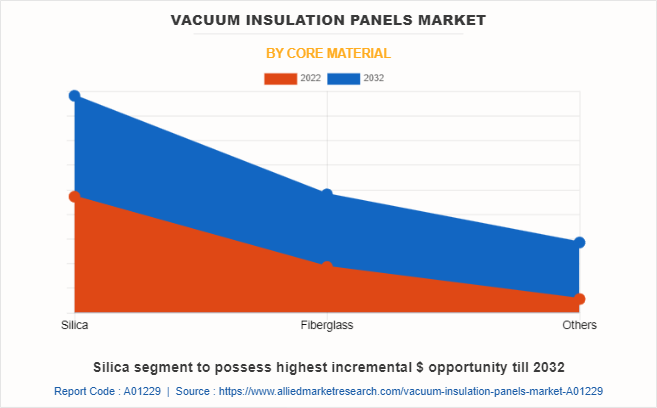
By core material, the silica segment accounted for nearly half of the global vacuum insulation panels market share in 2022. It accounted for approximately 47.78% of the share of the global market in 2020, as silica-based vacuum insulation panel offers high thermal insulation properties compared to other materials. In addition, their long life, spanning over 60 years, is the reason they are used in building constructions. The presence of excellent properties compared to other conventional thermal insulation products will provide lucrative opportunities for the development of the market, during the forecast period.
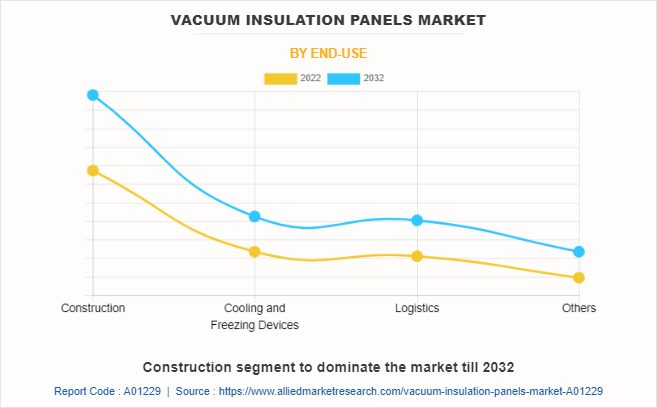
By end use, the construction segment held nearly half of the global market share in 2022. The construction sector accounted for the highest market share, owing to increased installation of vacuum insulation panels products in commercial, infrastructure, and other projects. This is mostly due to the maximum consumption of vacuum insulation panels in residential & underground constructions. Vacuum insulation panels also offer other advantages in the construction sector, such as the reduced thickness of building components, providing increased indoor space and optimization of land use, and recyclability of constitutive materials after their service life. Hence, all such attractive properties have made it popular for applications in the construction sector.
Moreover, the rising number of building codes and policies mandating energy-efficient structures is further facilitating an increase in the usage of eco-friendly and energy-conserving materials in the construction sector. This is expected to increase the application of vacuum insulation panels in the construction industry during the forecast period.
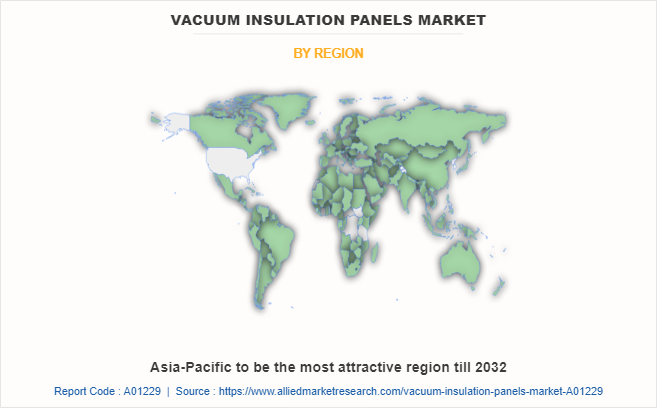
By region, Asia-Pacific accounted for more than two-fifths of the market share in 2022. Asia-Pacific is the leading region in terms of demand for vacuum insulation panels and is expected to maintain its dominance during the forecast period. The high adoption of vacuum insulation panels products in the region would continue to bolster the vacuum insulation panels market size.
Asia-Pacific is the leading region in terms of demand for vacuum insulation panels and is expected to maintain its dominance during the forecast period. The high adoption of vacuum insulation panels products in the region is expected to continue to boost the vacuum insulation panels market size. The major factors driving the growth of the market are the augmenting demand for insulated panels in the construction industry and the growing need for refrigerated and processed food.
In modern-day construction, the use of insulation materials is essential for industrial construction applications. The specific demand for energy in industrial buildings can be significantly reduced with modern insulation. The scope of applications is extremely diverse and even includes the construction of industrial buildings using insulated roof and wall panels. In industrial applications, building insulation materials witness major demand from cold storage buildings and warehouses. This rapid increase in the number of cold storage facilities is due to the growing demand from consumers, which is a result of changing lifestyles and advanced technologies. The expansion of retail food chains by multinational companies has led to an increase in the demand for cold storage. These factors, in turn, are expected to increase the demand for building insulation materials across the region.
Asia-Pacific Market Outlook
Asia-Pacific occupies the largest part of the vacuum insulation panels market and consists of countries such as China, India, Japan, South Korea, Australia, and rest of Asia-Pacific. The rapid growth in the development of the market is due to the robust demand for vacuum insulation panels (VIPs) from the construction as well as logistics, and warehouse industries. In India, the government’s target for investing $120.5 billion, for developing 27 industrial clusters, is expected to boost commercial construction in the country.
In Indonesia, the government planned to invest about $450 billion in the construction sector, by 2021, which is expected to provide a boost to residential construction in the country. Hence, all such investments and planned projects in the Asia-Pacific countries are providing a boost to construction activities in the region, which are anticipated to drive the demand for VIPs in the region, during the forecast period. Moreover, recent policy reforms in India, such as the Real Estate Act, GST, REITs, and others, are expected to reduce approval delays and strengthen the construction sector over the next few years. The development of these construction activities has a certain impact on the growth of the vacuum insulation panels market.
Impact of COVID-19 on Global Vacuum Insulation Panels Market
The COVID-19 pandemic had a significant impact on the vacuum insulation panels market. Disruptions in the global supply chain due to lockdowns and factory closures have led to potential delays and shortages in the production and distribution of vacuum insulation panels. The construction industry, a major consumer of vacuum insulation panels, experienced a slowdown as projects were put on hold or delayed, thereby affecting the demand for building materials, including vacuum insulation panels.
Changes in consumer behavior, such as remote work and reduced travel, may have influenced the demand for energy-efficient materials like vacuum insulation panels. However, government stimulus packages and policies focused on promoting sustainability and energy efficiency in construction could have positively influenced the market. It is important to note that the exact impact of COVID-19 on the vacuum insulation panels market may vary depending on regional factors, industry dynamics, and individual company circumstances.
Impact of Russia-Ukraine War on Global Vacuum Insulation Panels Market
The conflict between Russia and Ukraine potentially impacts the vacuum insulation panels market in several ways. Supply chain disruptions may arise due to trade restrictions and political instability, leading to a shortage of raw materials and delays in production. Market uncertainty may discourage investments and hinder market growth as businesses become cautious amid unpredictable situations. Geopolitical factors, such as economic sanctions, will affect the global trade of vacuum insulation panels, requiring companies to adapt their supply chains.
Additionally, a decline in construction activities and regional demand for vacuum insulation panels may occur if the conflict leads to economic downturns in Russia and Ukraine. However, the precise impact on the vacuum insulation panels market will depend on the duration and severity of the conflict and the responses of the various stakeholders involved.
Competitive Landscape
The key players operating in the global vacuum insulation panels market are BASF SE, Kingspan Group plc, Panasonic Holdings Corporation, Microtherm, Evonik Industries AG, va-Q-tec AG, Avery Dennison Corporation, Morgan Advanced Materials, Kevothermal, LLC, and Knauf Insulation. The above-mentioned companies are competing for the share of the market through product launches, joint ventures, partnerships, and expanding the production capabilities to meet the future demand for the vacuum insulation panels market in the forecast period.
Key Benefits For Stakeholders
- This report provides a quantitative analysis of the market segments, current trends, estimations, and dynamics of the vacuum insulation panels market analysis from 2022 to 2032 to identify the prevailing vacuum insulation panels market opportunities.
- The market research is offered along with information related to key drivers, restraints, and opportunities.
- Porter's five forces analysis highlights the potency of buyers and suppliers to enable stakeholders make profit-oriented business decisions and strengthen their supplier-buyer network.
- In-depth analysis of the vacuum insulation panels market segmentation assists to determine the prevailing market opportunities.
- Major countries in each region are mapped according to their revenue contribution to the global market.
- Market player positioning facilitates benchmarking and provides a clear understanding of the present position of the market players.
- The report includes the analysis of the regional as well as global vacuum insulation panels market trends, key players, market segments, application areas, and market growth strategies.
Vacuum Insulation Panels Market Report Highlights
| Aspects | Details |
| Market Size By 2032 | USD 12.7 billion |
| Growth Rate | CAGR of 4.7% |
| Forecast period | 2022 - 2032 |
| Report Pages | 282 |
| By Type |
|
| By Raw Material |
|
| By Core Material |
|
| By End-Use |
|
| By Region |
|
| Key Market Players | Avery Dennison Corporation, Morgan Advanced Materials PLC, Kingspan Group plc, Va-Q-Tec AG, Evonik Industries AG, Knauf Insulation, BASF SE, Microtherm, Panasonic Corporation, Kevothermal LLC |
Analyst Review
A vacuum insulation panel comprises a rigid, profoundly permeable center material encased in a thin, gas-tight external envelope, which is emptied and fixed to prevent outside gases from entering the board. The mix of permeable material and the vacuum brings a high heat resistance, which are considered more for slender protection in applications where space is at a premium.
The use of vacuum insulation panels in the construction industry has witnessed the highest growth rate globally owing to a rise in infrastructure activities. The vacuum insulation panels are applied for their excellent thermal insulation properties, thus lowering thermal conductivity in the construction industry.
The market for vacuum insulation panels in Asia-Pacific is anticipated to attract leading manufacturers for investment, owing to the development in the infrastructure industry in China, India, Korea, and Japan that drives the market in the region. Construction is the most lucrative end-user industry for the market, owing to vacuum insulation panels increased demand in the construction industry. China, Japan, Korea, UAE, Qatar, and India are the major revenue contributors in Asia-Pacific and LAMEA. Currently, there are several airport construction projects, either in the development or planning stage, in China. These include Beijing Capital International Airport, Chengdu Shuangliu International Airport, Guangzhou Baiyun International Airport, and others. Besides, the government rolled out massive construction plans, including making provision for the movement of 250 million people to its new megacities, over the next 10 years. The above-mentioned investments and plans will provide lucrative opportunities for the development of the market during the forecast period.
Upsurge in the construction industry and developing package industry are the key factors boosting the Vacuum insulation panels market growth.
The market value of Vacuum insulation panels in 2032 is expected to be $12.7 billion
BASF SE, Kingspan Group plc, Panasonic Holdings Corporation, Microtherm, Evonik Industries AG, va-Q-tec AG, Avery Dennison Corporation, Morgan Advanced Materials, Kevothermal, LLC, and Knauf Insulation
Construction application is projected to increase the demand for Vacuum insulation panels Market
The vacuum insulation panels market is segmented on the basis of raw material, core material, type, end use, and region. By raw material used for manufacturing, the market is segmented into plastics and metals. The core material segment of the vacuum insulation panels market is broadly classified into silica, fiberglass, and others. The type segment of the vacuum insulation panels market is broadly classified into flat panel and special shape panel. The end use of the market is categorized into construction, cooling & freezing devices, logistics, and others. The global vacuum insulation panels market is analyzed across North America, Europe, Asia-Pacific and LAMEA.
Energy codes and regulations for new buildings is the Main Driver of Vacuum insulation panels Market.
Loading Table Of Content...
Loading Research Methodology...



